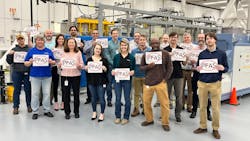Milliken’s Blueprint for Removing PFAS from Operations
For a company that isn’t one to toot its own horn, when the announcement came on Feb. 22, 2023, that Milliken & Company, a textile manufacturer of 18,000 products, became the first U.S.-based multi-market textile manufacturer to remove per- and poly-fluoroalkyl substances, commonly referred to as PFAS, from its textile fibers and finishes portfolio, it made an impact.
The journey began in 2020 when the company decided to evaluate its use of FPAS. “Our first step was to really dive into where PFAS were used across our seven business lines,” explains Jeff Strahan, Ph.D., director of research, compliance, and sustainability for Milliken. “This process took a while as it’s used in a variety of ways, in different forms for different customers."
The focus was narrowed to three areas that used PFAS: durable water repellency (DWR), soil release and oil repellency. For DWR, alternative solutions were available. But for soil release, an alternative had to be created.
“To accomplish our goal, the most important thing was getting together a cross-functional team. The family (the family that founded the company in 1865 still runs it today), the CEO, as well as sales, R&D, business development, manufacturing and sourcing were all on the team. We have a really robust product development process and this is almost like developing a new product. We went through all of the gates for a new product. For example, can sourcing find enough of the products we would need to substitute for the PFAS, how would it be delivered, how would it be tested, etc.”
For soil release, the company ended up devising a new product after going through a rigorous R&D process. “ Our product, which we have IP for, performs better than some PFAS-containing finishes,” notes Strahan.
It was the oil repellency that really tested the company’s mettle. “Finding a chemical that is oil-repellent is really the holy grail. No one can do this, and everyone has tried for many years, so we talked to our customers to see what adjustments could be made by not using FPAS. For some, it worked but for others, since we did not find an alternative oil repellency, we ended up leaving those lines of business.”
All of this happened quickly and by Dec. 31, 2022, the Textile Business at Milliken had removed PFAS-based finishes and fibers, which span multiple industries including flame-resistant, military, uniform and decor fabrics.
Why The Rush?
A number of factors converged that led to Milliken creating a very quick timeline. “There are three specific reasons we had to get this done quickly,” says Strahan. “The first is regulation. If you look at the current situation, the EPA has a number of regulations around PFAS, and there are various state regulations as well. And if you are moving products through different states that have different regulations it’s very difficult to navigate. But it’s the future situation, that is the most pressing. California has passed a bill that restricts the use of PFAS in new textile products manufactured, sold, or distributed by 2025. So, when you look at product cycles that’s a very quick turnaround.”
And while the U.S. is active in removing these forever chemicals, as they are called, so is the rest of the world. And some of their timelines are even quicker. The European Chemicals Agency released last month a proposed phaseout of PFAS in most products. The rule is expected to enter into force by 2025.
“The next factor was that some customers were coming to us telling us that they are phasing it out or didn’t want PFAS in their products,” Strahan.
And the other major factor is the supply chain. “With 3M announcing that by the end of 2025, it will no longer manufacture PFAS, there is no one to replace them.”
Of course, on top of those reasons, Strahan says Milliken believes it’s the right thing to do. The company has a long-standing sustainability policy. This achievement follows Milliken’s recent announcement that its science-based net-zero targets were approved by the U.N.-backed Science Based Targets initiative (SBTi).
Best Practices
While Strahan said that he is extremely proud of what the team accomplished in such a brief time, when pressed on how he could have improved the process he said found a couple of areas. “I wish that we had a better view of the adoption cycle of each product line. For example, while some lines needed just a few weeks of testing the alternative chemical solutions, others needed much longer, and all of this has to be factored into when products need to be delivered.”
Communication is another area that should also be closely examined. “Our salespeople did an excellent job of finding out customers’ needs and questions which enabled us to address those issues. We had several communication formats, but there were probably even more ways to communicate. I would tell anyone to communicate as much as you possibly can.”
And in this case, the message one that Strahan feels is one of the most important of his career.
About the Author
Adrienne Selko
Senior Editor
Email [email protected]
Adrienne Selko is also the senior editor at Material Handling and Logistics and is a former editor of IndustryWeek.


